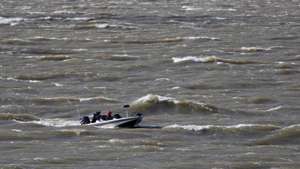
(Editor's note: An article in the March issue of B.A.S.S. Times told readers what Russ Lane and Kelly Jordon do to cope with heavy winds. Now, find out what Michael Iaconelli does when it's windy, and learn how to cast into the wind.)
Adding drag can slow the drift of the boat, which Bassmaster Elite Series pro Mike Iaconelli accomplishes with one or two drift socks or sea anchors. By slowing the pace of his drift, he is able to fish straight up-and-down, using the boat to move his lure. "I use drift socks — usually one or two, but up to three in a real heavy wind. I'm basically using my trolling motor to stay on contour breaks," said Iaconelli.
"I'll get in my area, whether that's on a flat, off a drop, on a hump or off a point, and I'll go upwind of the area and drop my [drift] socks. I'll then use the trolling motor while watching my depthfinder to stay on my path." Iaconelli prefers to fish dragging-type baits like tube jigs, drop shots, Carolina rigs, worms and similar bottom-working lures.
"Remember that these are controlled drifts; you're using the wind to move your baits and cover a lot of water," said Iaconelli. "I'll drop that tube down there, I'll stay on that contour break and make my controlled drift, and when I get to the end of the area where I believe the bass are, I'll pull up the socks, start the outboard, run back upwind and do it all over again.
" You have to be careful when using sea anchors in heavy waves that might swamp the boat, he warned. When possible, though, he deploys one drift sock on one side of the bow and the other in the stern, on the opposite side.
Tips for casting into the wind
When a situation demands casting directly into the wind, remember several tricks that should make the task a little more manageable.
One of the most important things to keep in mind when casting upwind is that although you will lose casting distance, you will have the best accuracy casting directly into the wind. First, switch to a slightly heavier lure or sinker. If you would ordinarily fish a 1/2-ounce lipless crankbait, tie on the same bait in 3/4 ounce.
Resist the temptation to go to an even heavier bait, though. A 1-ounce bait might achieve longer casts, but a somewhat lighter lure will be easier to control, especially when you're retrieving with the current. An effective technique is to angle your casts so that the wind sweeps your bait in front of the fish. To accomplish that, be sure to cast at no greater than a 45 degree angle to the wind.
Limiting the angle of the wind that pushes against your line not only gives you more control of the speed and path of the lure, but it also helps you maintain contact so you feel the lure ticking grass or tell when a fish is biting.
Control the bow in your line by raising or lowering the rod tip. Holding the rod tip close to the water will place the line on or in the water and limit wind drag and its effect on the speed of the retrieve.
To get more bow to overcome an errant cast or speed up the lure, raise the rod tip and expose more line to the wind's drag.




